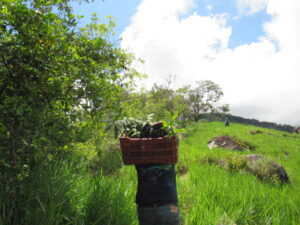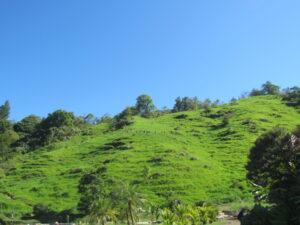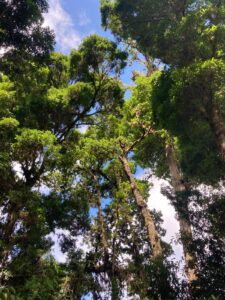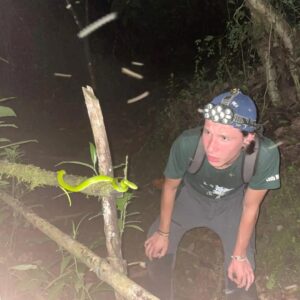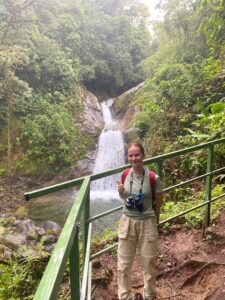
After a dry season that lived up to its name, and some very sporadic rain through March and April, we are glad to see that the rainy season seems to have finally arrived! At Cloudbridge we love the beginning of the rainy season, not only because the plants seem to enjoy it, but also because it is time for planting trees! Given that we are in the enviable position of having already reforested all of the available land within the reserve, we are excited to expand our reach and help other landowners also recover the native forests of the area. We are very pleased to have recently kicked off this new phase of Cloudbridge´s reforestation projects, with a major tree planting day on June 1st.
Planting 500 trees from our native tree nursery species will eventually transform this grassy hillside in Los Angeles de Rivas into a biodiverse forest similar to what we have at Cloudbridge. I want to give a big thanks here to all who have made this reforestation possible: Dale and Jenny, their excellent farmworkers and everybody who hiked up the steep hill and planted trees!
Photo credit: Laura Spackman
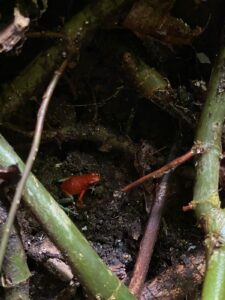
In addition to reforestation, environmental education has been a guiding principle of Cloudbridge since the beginning. Of course our research and volunteer program is a main focus for us, but we are also pleased to receive student groups who are interested in learning more about the Cloud Forest. Ecological Restoration students from Pitzer College have long been one of these student groups, and this month we were able to repay the visit, when Cloudbridge staff members attended student presentations at Pitzer College´s Firestone Center for Ecological Restoration. It was a great opportunity to strengthen the collaborative relationship that exists between the organizations, and we were delighted to see the work of students who were completing a semester abroad, as well as meet their host families. After these activities, we enjoyed going for a short walk to a nearby waterfall, and thank to Max´s keen eyes we found two individuals of Oophaga granulifera, the poison dart frog.
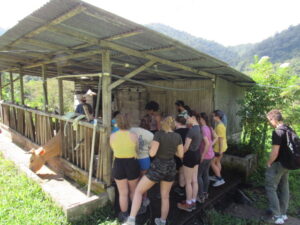
In May we also received a group of Agricultural Students from Western Kentucky University, who not only visited local farms but also enjoyed learning about the research and volunteer program at Cloudbridge, and greatly enjoyed a birding hike up to Catarata Don Victor. This image shows the group at Quesos Canaan, an outstanding family farm and quality cheese business. Thank you Steven, Wilbur and Katia for an excellent tour! Though nature reserves such as Cloudbridge serve an important role as a refuge for wildlife and humans, it is important to point out that sustainable productive systems and agroecological farms are play an important role in a healthy response to the climate crisis. It is possible to design our productive systems in such a way that they provide us with ecosystem services as well as delicious food.
Researchers and Volunteers
Hello my name is Jérôme and I am from the Netherlands. I am studying animal management in Leeuwarden, with a specialization into wildlife management. I was lucky enough to be able to do my experience internship here a Cloudbridge. I have been here for almost 4 months and I have 1 more to go. During my time here I designed my own research on herpetofauna (reptiles and amphibians) abundance and diversity in different environments of the cloudforest. Besides my own research I have had the opportunity to learn about many other animals that live in this forest and their effects on this unique ecosystem. Cloudbridge has also allowed me to also think about myself as an individual and my place in the world. Overall it’s been a great experience I would recommend to anyone with a desire for adventure!
Hi ? My name is Anaëlle and I’m from France. I’m in Cloudbridge for a 10 weeks internship as a researcher, to finish my bachelor’s degree in Biology (University of Lille). I’m here to study benthic fauna in the water streams, so the little organisms, and see if there is an impact of altitude on these communities. I’m really happy to be here, in such a gorgeous place, with unique fauna & flora.
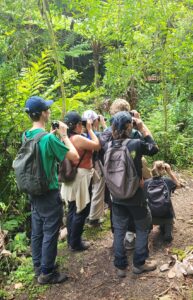
Pics from around the reserve
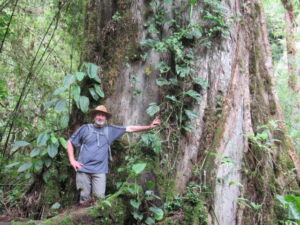
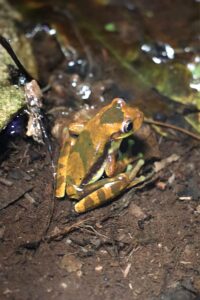
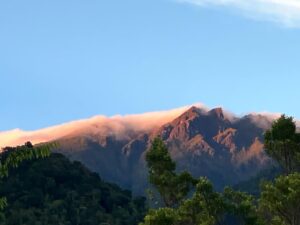
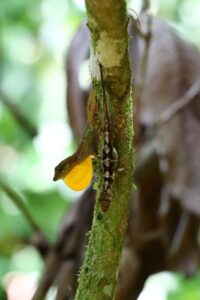
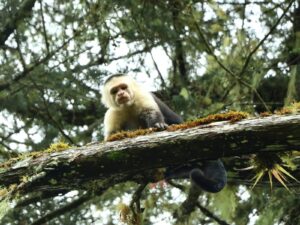
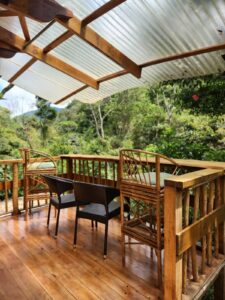
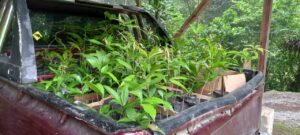
Suggested Reading
- It stands to reason that birdwatchers and other people who engage with the natural world will have a stronger drive to try and protect ecosystems and otherwise take environmental action. For this reason, it is important to introduce young people of all demographics to the joy of birdwatching or otherwise interacting with nature. Three years ago, Christian Cooper had a potentially life-threatening interaction after asking a woman to please keep her dog on a leash in a zone of Central Park that is a haven for wildlife. In this article, he describes some of his experiences as a life-long birdwatcher of color.
- As we have mentioned before, a big part of the reason that Costa Rica is an environmental leader despite its tiny size has to do with governance, and in this article, George Monbiot describes some of the policies enacted by Alvaro Umaña during the 1980s, which allowed a shift in deforestation rates that continues to benefit Costa Rica.
- Governance is at the core of the dilemmas faced by Western States which are still facing severe water issues despite heavy snowfall this winter. In this article, Outside editor Bill Gifford talks about the decisions that are being made around the management of the Great Salt Lake in Utah.
- At the beginning of this month, Margaret Roach invited readers to have a No-Mow May, and let their gardens become a sanctuary for pollinators. The same columnist also closed the month with a lovely description of why it is important we try to be mindful of our practices and strive to reduce noise pollution and light pollution in an effort to provide a more healthy habitat for wildlife.

